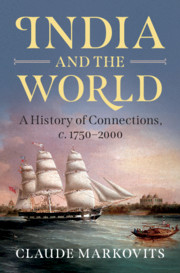Book contents
- India and the World
- India and the World
- Copyright page
- Dedication
- Contents
- Figures
- Tables
- Acknowledgements
- Chronology
- Glossary
- Abbreviations
- Map of India’s Global Connections, 1750–2000
- Introduction
- 1 India in the Global Economy
- 2 India in Global Human Circulations
- 3 India in the World of Wars and Peace
- 4 India in the Global Exchange of Ideas
- 5 India in Global Cultural Circulations
- 6 Indians and Others
- 7 Two Global Indian Events
- Conclusion
- Bibliography
- Index
5 - India in Global Cultural Circulations
Published online by Cambridge University Press: 19 March 2021
- India and the World
- India and the World
- Copyright page
- Dedication
- Contents
- Figures
- Tables
- Acknowledgements
- Chronology
- Glossary
- Abbreviations
- Map of India’s Global Connections, 1750–2000
- Introduction
- 1 India in the Global Economy
- 2 India in Global Human Circulations
- 3 India in the World of Wars and Peace
- 4 India in the Global Exchange of Ideas
- 5 India in Global Cultural Circulations
- 6 Indians and Others
- 7 Two Global Indian Events
- Conclusion
- Bibliography
- Index
Summary
I focus on three fields of cultural activity – literature, the visual arts and cinema – to uncover how Indian cultural producers situated themselves within a global picture. In literature, there was a contrast between the fascination exercised by ancient Indian cultural productions, epitomised by the extraordinary success of Kalidas’s Sakuntala, and the relative indifference of the outside world towards more recent productions. An exception was the amazing popularity for a decade or two of Bengali poet Rabindranath Tagore, after he was awarded the Nobel Prize for literature in 1913. The next Indian writer to obtain worldwide success was Salman Rushdie, who inaugurated a boom period for Indian diaspora authors writing in English. I focus on novelists and poets writing in the vernaculars who sought to define a specific Indian idiom. In the visual arts, the tribulations of Indian painters trying to define an authentic Indian art vocabulary are juxtaposed with the difficulty Indian architects had in defining a modernist style adapted to the country. Finally, I look at cinema, the most successful of Indian cultural industries, trying to find reasons for Indian films’ popularity abroad.
- Type
- Chapter
- Information
- India and the WorldA History of Connections, c. 1750–2000, pp. 151 - 179Publisher: Cambridge University PressPrint publication year: 2021



